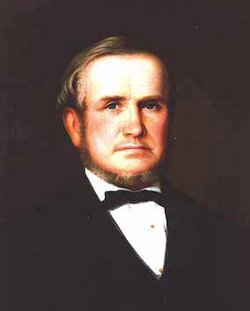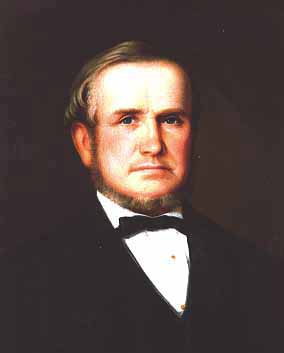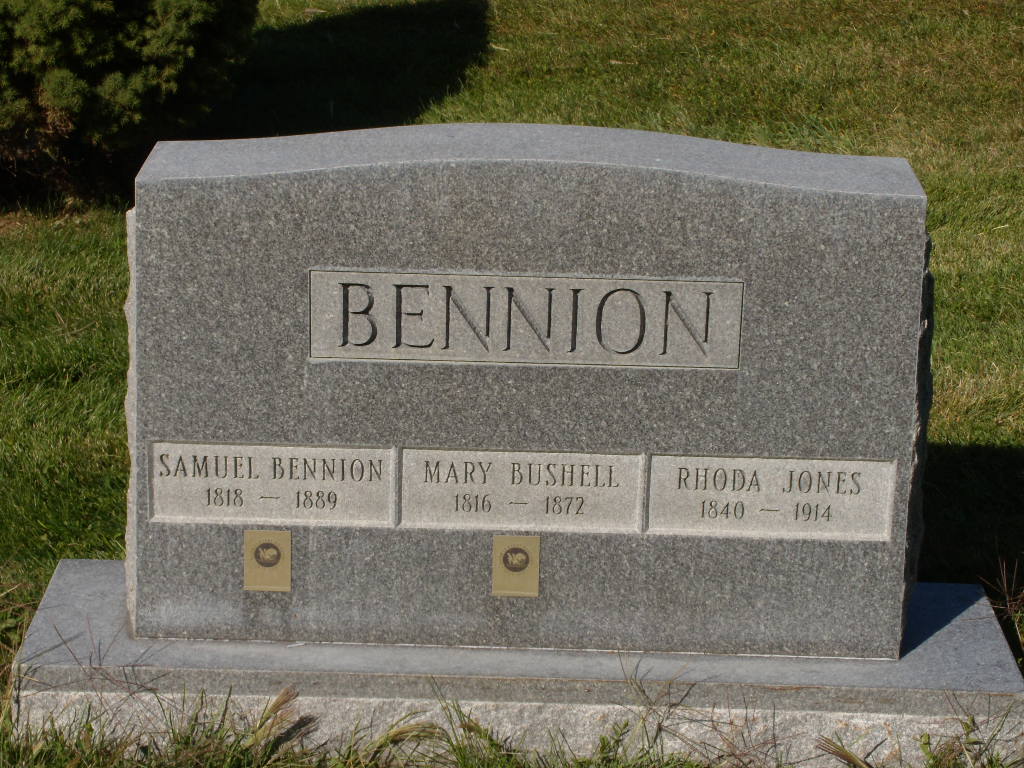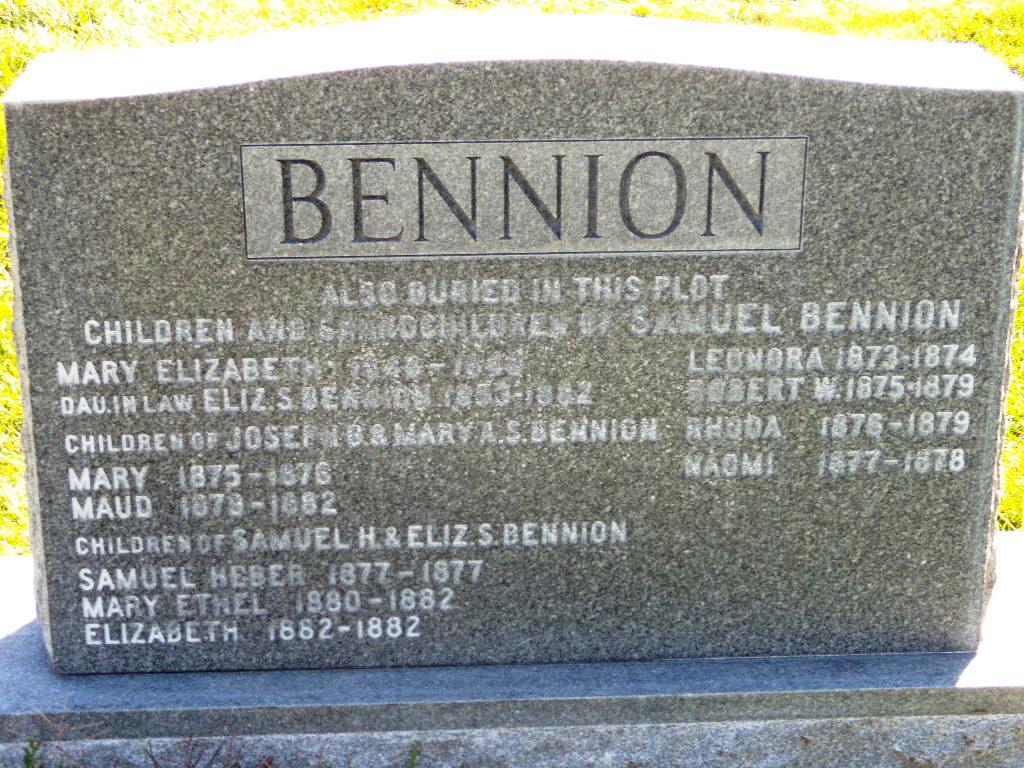Bennion, Samuel, Bishop of the North Jordan Ward, Salt Lake county, Utah, is a son of John Bennion and Elizabeth Roberts, and was born in the parish of Harwerden, County of Flint, North Wales, Dec. 11, 1818. In 1840 he saw the first Latter-day Saint missionaries (Elders John Taylor and Joseph Fielding) in a chapel in Liverpool, where Elder Bennion at that time carried on business as a baker. He was baptized Sept. 30, 1842. Having made the necessary arrangements to gather to the Saints' headquarters in America, he sailed from Liverpool, together with a few saints, March 30, 1845, on board the ship "Parthenon," landed in New Orleans May 12th, and continued up the Mississippi river to Nauvoo, Ill., where he arrived May 23rd. He bought a farm (85 acres) of Daniel H. Wells, about seven miles east of Nauvoo, on the La Harpe road, where he built a two-story brick building. The following spring (May 19, 1846 ), he was forced to vacate his possessions because of the persecutions. Together with a small company of Saints he crossed the Mississippi river at Fort Maddison, stopped at Garden Grove, Iowa, where he raised a crop and remained there the following winter. Early in the spring of 1847 he proceeded to the main camp of the Saints on the Missouri river, and after having made a trip to Missouri after provisions, he crossed the plains in Bishop Edward Hunter's company, arriving in Salt Lake City in October, 1847, with Capt. Jos. Horne's fifty. Early in 1849 he located himself and family on the west side of the river Jordan, and thus became one of the first settlers in that section of the country. In February, 1850, he went to Provo, in George D. Grant's company of minute men and participated in the battle with the Indians under Big Elk, Feb. 8th and 9th. The winter of 1855-56 he spent in Rush Valley, together with Luke S. Johnson and others. In 1857 he participated in the Echo Canyon expedition, and on Sept. 27, 1863 he was appointed to reside over the North Branch of the West Jordan Ward, which position he occupied until the branch, June 17, 1877, was organized as a Ward, when he was ordained a High Priest and set apart to act as Bishop of the same. He held this position until the time of his death, which occurred in Taylorsville, Sept. 9, 1889. Bishop Bennion occupied many positions of honor and trust. For a number of years he acted as justice of the peace, served as selectman of Salt Lake county, was president of canal companies, and was throughout one of the leading men in Salt Lake county.
Our Pioneer Heritage, Vol. 13, p. 334
In the spring of 1848 with a group of other pioneers, the Mackays moved out of the fort and farmed land on the southeast in what later was called Forest Dale. January 9, 1849, Thomas Mackay, John Bennion, Samuel Bennion, Thomas Turbett, William Blackburst, William Farrer, John Robinson and James Taylor crossed the Jordan River on the ice and located near Joseph Harker at what is now about Thirty-third South and Fourteenth West. They made dugouts near the river on land that was later known as Little's Farm and in after years, was owned by Bishop McRae. They moved their families over there and some who had log houses at the fort, moved them over, but it was too difficult to get water from the river onto the land, so they moved about a mile farther south.
Our Pioneer Heritage, Vol. 14, p. 456
In 1880, Hyrum Bennion and his father, Samuel Bennion, and cousin, Samuel R. Bennion, formed a partnership and purchased from Archibald Gardner a water-powered burr mill. It was a lumber building, constructed on piles driven into the ground on the banks of the Jordan. In 1891, the mill was enlarged and new machinery installed. Tom Tolhurst, John J. Jacobs, Neils H. Jensen and a Mr. Herman worked in the mill along with the sons of Hyrum Bennion. When Mr. Tolhurst left the Bennion Milling Company, he owned and operated flour mills in Payson and Santaquin. His brother, Charles Tolhurst, was also a mill owner and operator in that area. In 1908, the mill on the river burned down and was completely destroyed. Being in the fall of the year, the mill was full of wheat purchased from the farmers. They saved some of the flour; however, almost all the wheat in the mill was destroyed. Farmers came and dug the wheat out of the ruins to use as feed for their stock.
Bennion, Samuel, Bishop of the North Jordan Ward, Salt Lake county, Utah, is a son of John Bennion and Elizabeth Roberts, and was born in the parish of Harwerden, County of Flint, North Wales, Dec. 11, 1818. In 1840 he saw the first Latter-day Saint missionaries (Elders John Taylor and Joseph Fielding) in a chapel in Liverpool, where Elder Bennion at that time carried on business as a baker. He was baptized Sept. 30, 1842. Having made the necessary arrangements to gather to the Saints' headquarters in America, he sailed from Liverpool, together with a few saints, March 30, 1845, on board the ship "Parthenon," landed in New Orleans May 12th, and continued up the Mississippi river to Nauvoo, Ill., where he arrived May 23rd. He bought a farm (85 acres) of Daniel H. Wells, about seven miles east of Nauvoo, on the La Harpe road, where he built a two-story brick building. The following spring (May 19, 1846 ), he was forced to vacate his possessions because of the persecutions. Together with a small company of Saints he crossed the Mississippi river at Fort Maddison, stopped at Garden Grove, Iowa, where he raised a crop and remained there the following winter. Early in the spring of 1847 he proceeded to the main camp of the Saints on the Missouri river, and after having made a trip to Missouri after provisions, he crossed the plains in Bishop Edward Hunter's company, arriving in Salt Lake City in October, 1847, with Capt. Jos. Horne's fifty. Early in 1849 he located himself and family on the west side of the river Jordan, and thus became one of the first settlers in that section of the country. In February, 1850, he went to Provo, in George D. Grant's company of minute men and participated in the battle with the Indians under Big Elk, Feb. 8th and 9th. The winter of 1855-56 he spent in Rush Valley, together with Luke S. Johnson and others. In 1857 he participated in the Echo Canyon expedition, and on Sept. 27, 1863 he was appointed to reside over the North Branch of the West Jordan Ward, which position he occupied until the branch, June 17, 1877, was organized as a Ward, when he was ordained a High Priest and set apart to act as Bishop of the same. He held this position until the time of his death, which occurred in Taylorsville, Sept. 9, 1889. Bishop Bennion occupied many positions of honor and trust. For a number of years he acted as justice of the peace, served as selectman of Salt Lake county, was president of canal companies, and was throughout one of the leading men in Salt Lake county.
Our Pioneer Heritage, Vol. 13, p. 334
In the spring of 1848 with a group of other pioneers, the Mackays moved out of the fort and farmed land on the southeast in what later was called Forest Dale. January 9, 1849, Thomas Mackay, John Bennion, Samuel Bennion, Thomas Turbett, William Blackburst, William Farrer, John Robinson and James Taylor crossed the Jordan River on the ice and located near Joseph Harker at what is now about Thirty-third South and Fourteenth West. They made dugouts near the river on land that was later known as Little's Farm and in after years, was owned by Bishop McRae. They moved their families over there and some who had log houses at the fort, moved them over, but it was too difficult to get water from the river onto the land, so they moved about a mile farther south.
Our Pioneer Heritage, Vol. 14, p. 456
In 1880, Hyrum Bennion and his father, Samuel Bennion, and cousin, Samuel R. Bennion, formed a partnership and purchased from Archibald Gardner a water-powered burr mill. It was a lumber building, constructed on piles driven into the ground on the banks of the Jordan. In 1891, the mill was enlarged and new machinery installed. Tom Tolhurst, John J. Jacobs, Neils H. Jensen and a Mr. Herman worked in the mill along with the sons of Hyrum Bennion. When Mr. Tolhurst left the Bennion Milling Company, he owned and operated flour mills in Payson and Santaquin. His brother, Charles Tolhurst, was also a mill owner and operator in that area. In 1908, the mill on the river burned down and was completely destroyed. Being in the fall of the year, the mill was full of wheat purchased from the farmers. They saved some of the flour; however, almost all the wheat in the mill was destroyed. Farmers came and dug the wheat out of the ruins to use as feed for their stock.
Family Members
-
![]()
John Rowland Bennion
1840–1899
-
![]()
James Bennion
1841–1844
-
![]()
William Bennion
1842–1844
-
![]()
Hyrum Bushell Bennion
1847–1926
-
![]()
Mary Elizabeth Bennion
1848–1849
-
![]()
Joseph Bushell Bennion
1850–1888
-
![]()
Emma Bennion Lindsay
1851–1941
-
![]()
Rebecca Ann Bennion Sharp
1853–1946
-
![]()
Alice Jane Bennion Harker
1856–1929
-
![]()
Wilford Bennion
1870–1936
-
![]()
Leonora Bennion
1873–1874
-
![]()
Robert William Bennion
1875–1875
-
![]()
Rhoda Bennion
1876–1879
-
![]()
Naomi Bennion
1877–1878
-
![]()
Arthur Bennion
1881–1945
Advertisement
Advertisement


























